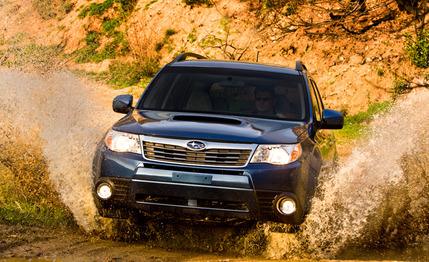
 First Drive Review
First Drive Review
I have only one friend who drives a Subaru Forester, but I submit she fits the Forester mold: She is what MBAs would describe as an “urban adventurer,” often seen driving with her three blond-and-brownish pound-rescue dogs with indeterminate family trees. She has no immediate plans to drive the Yukon Trail but likes to know that if she had to, her Forester is ready.
The press presentation for the substantially redesigned 2009 Subaru Forester is full of high-resolution photos of people like her, enjoying the outdoors in a state of near-glee apparently attainable only in a Subaru. They presumably listen to NPR or attend poetry readings in those rare moments not spent in the great outdoors. Such is the very comfortable, very profitable niche that Subaru in general and the Forester in particular have carved.
Fits the Same Mold
There is nothing about the 2009 Forester that would threaten that; in fact, designers and engineers were very attentive to the requests from current owners not to go overboard in making the Forester much bigger or more powerful—and consequently more expensive. What emerged from those customer focus sessions was a vehicle that is much like the first- and second-generation Foresters, only more so.
Yes, it is larger, but not substantially: The wheelbase stretches from 99.4 inches to 103.0, and overall length is up from 176.6 inches to 179.5. Width grows from 68.3 inches to 70.1. And the rear suspension goes from struts to the more compact multilink arrangement carried over from the latest Imprezas, the end result being a substantially roomier five-passenger interior. Four actual adults will now fit comfortably in the 2009 Subaru, and rear-seat passengers—be they people or dogs—can only appreciate the added space, especially the extra 5.2 inches of width in the cargo area. A side benefit from that new rear suspension is a smoother, more controlled ride, especially over roughish terrain.
Same 2.5-Liter Boxer-Fours
Under the hood you’ll find the good ol’ 2.5-liter, four-cylinder boxer engine, albeit revised for 2009 with a new intake system, revised camshaft timing, and a modified exhaust system. The base engine pumps out 170 horsepower and 170 pound-feet of torque at 4400 rpm. If you want more, the XT model adds a turbocharger for 224 horsepower and 226 pound-feet of torque at a low 2800 rpm. If most of your driving is done in the city limits, the naturally aspirated engine is fine, but the turbo makes highway driving much more fun and merging into traffic less dramatic.
Transmissions are the carry-over five-speed manual or four-speed automatic for the base-model engine; the turbo gets only the four-speed automatic. Yes, our favorite model, the hooligan turbo Forester with a manual, is gone. And why still just four speeds in the automatic? U.S. reps for Subaru say the Japanese don’t see the advantage of another gear or two just to say you have them (or maybe Subaru doesn’t want to invest significantly to develop one). We partly agree, but dealers will have more trouble making that argument to comparison-shopping customers. Regardless, the automatic works fine, spaced nicely to maximize power for either engine.